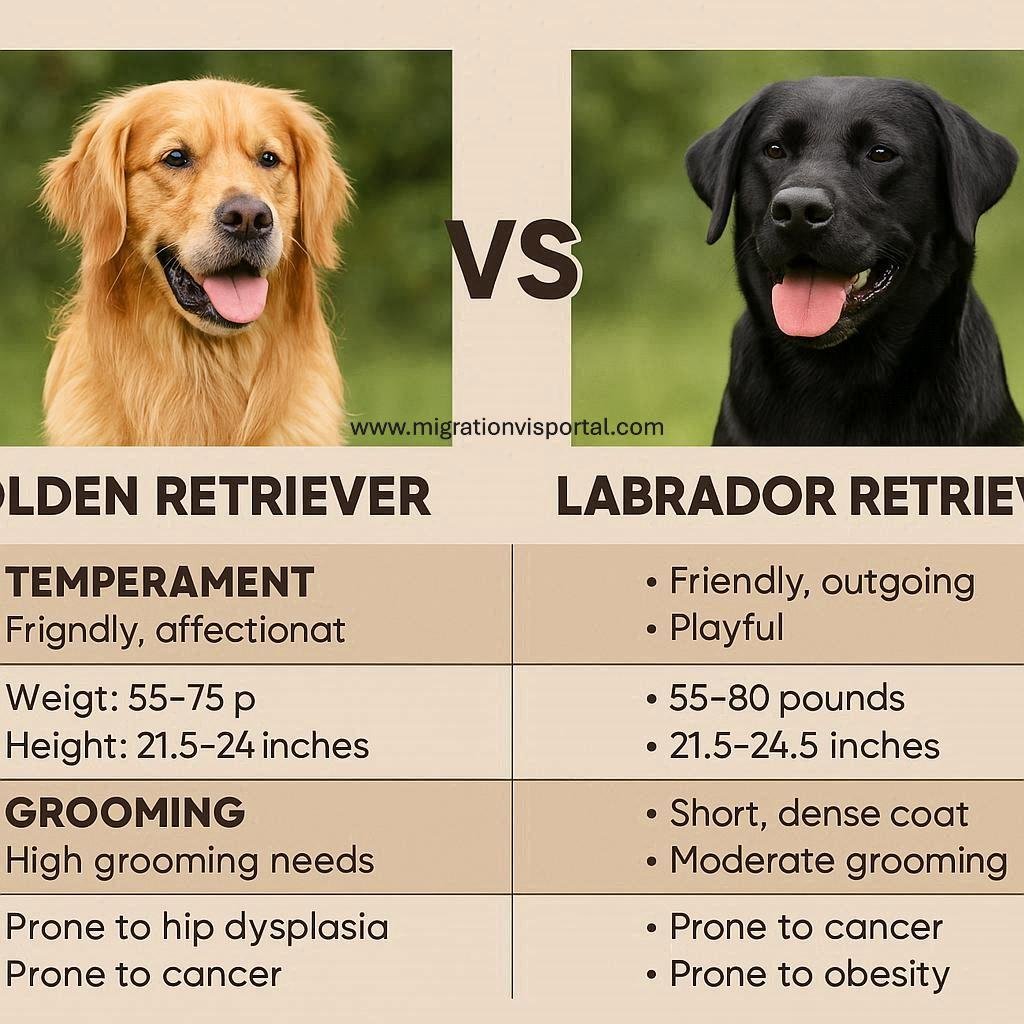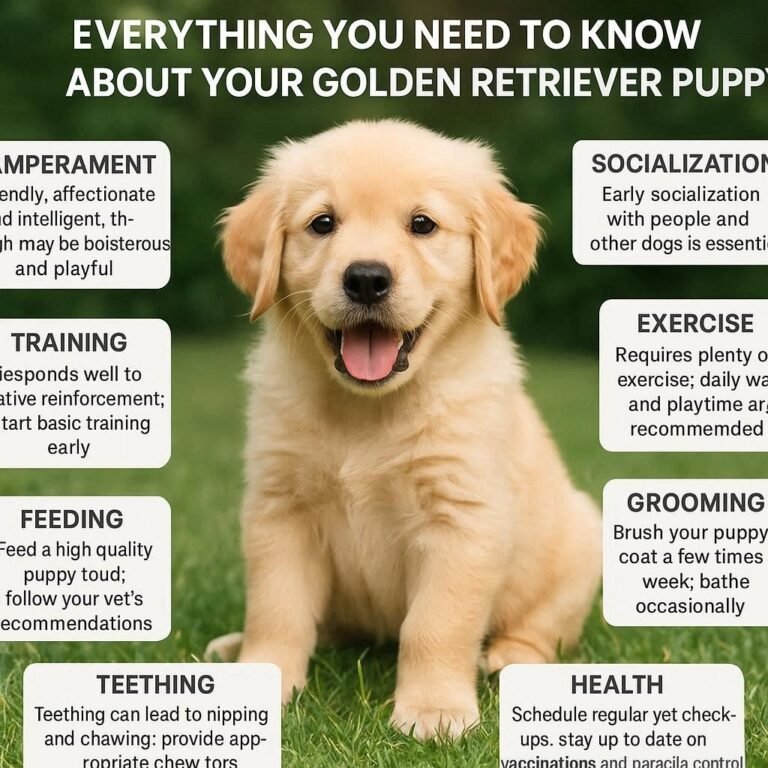Golden Retriever vs Labrador Retriever: Complete Breed Comparison Guide
Golden Retriever vs Labrador Retriever: Complete Breed Comparison Guide
Choosing between a **Golden Retriever** and a **Labrador Retriever** is one of the most common dilemmas for prospective dog owners. Both breeds consistently rank among America’s most beloved family dogs, and for good reason – they’re intelligent, loyal, and fantastic with children.
But despite their similarities, these two retriever breeds have distinct differences that can make one a better fit for your lifestyle than the other. Whether you’re a first-time dog owner or adding to your pack, understanding these differences is crucial for making the right choice.
In this comprehensive guide, you’ll discover everything you need to know about Golden Retrievers vs Labrador Retrievers, including their temperaments, care requirements, health considerations, and which breed might be perfect for your family.
Golden Retriever
Appearance
Golden Retrievers are instantly recognizable with their flowing, golden coats that range from light cream to deep gold. They have a sturdy, well-balanced build with a broad head, friendly eyes, and a constantly wagging tail. Their double coat is water-repellent with feathering on the chest, legs, and tail.
- Flowing, feathered coat
- Colors range from cream to dark gold
- Expressive, kind eyes
- Balanced, athletic build
Temperament & Personality
Golden Retrievers are renowned for their gentle, patient nature. They’re incredibly people-oriented and thrive on human companionship. These dogs are natural people-pleasers, making them excellent family pets and therapy dogs.
- Gentle and patient
- Highly social and friendly
- Eager to please
- Calm and even-tempered
- Great with children and other pets
Size & Weight
- Males: 65-75 pounds, 23-24 inches tall
- Females: 55-65 pounds, 21.5-22.5 inches tall
- Classification: Large breed
Energy & Exercise Needs
Golden Retrievers have moderate to high energy levels and require about 1-2 hours of daily exercise. They excel at activities like fetch, swimming, and hiking. Mental stimulation through training and puzzle games is equally important.
- 1-2 hours daily exercise
- Loves swimming and retrieving
- Benefits from mental stimulation
- Enjoys long walks and hikes
Health Considerations
Golden Retrievers are generally healthy but prone to certain genetic conditions:
- Hip and elbow dysplasia
- Heart conditions (subvalvular aortic stenosis)
- Eye problems (cataracts, progressive retinal atrophy)
- Cancer (higher risk than many breeds)
- Bloat (gastric torsion)
Average Lifespan: 10-12 years
Grooming & Care Tips
Golden Retrievers require regular grooming due to their long, double coat:
- Brushing: 3-4 times per week, daily during shedding seasons
- Bathing: Monthly or as needed
- Professional grooming: Every 6-8 weeks
- Nail trimming: Every 2-3 weeks
- Ear cleaning: Weekly
Labrador Retriever
Appearance
Labrador Retrievers have a short, dense, water-resistant double coat that comes in three colors: yellow, black, and chocolate. They have a strong, athletic build with a broad head, expressive eyes, and the characteristic “otter tail” that’s thick and strong.
- Short, dense double coat
- Three standard colors: yellow, black, chocolate
- Broad head with kind eyes
- Distinctive thick “otter tail”
- Athletic, muscular build
Temperament & Personality
Labs are known for their outgoing, friendly nature and boundless enthusiasm. They’re highly social, energetic, and maintain a puppy-like playfulness well into adulthood. Labs are excellent family dogs and natural athletes.
- Outgoing and friendly
- High energy and playful
- Social and people-oriented
- Intelligent and trainable
- Can be more boisterous than Golden Retrievers
Size & Weight
- Males: 65-80 pounds, 22.5-24.5 inches tall
- Females: 55-70 pounds, 21.5-23.5 inches tall
- Classification: Large breed
Energy & Exercise Needs
Labrador Retrievers are high-energy dogs that require substantial daily exercise. They were bred for retrieving waterfowl and have incredible stamina. Without adequate exercise, Labs can become destructive or overweight.
- 2+ hours daily exercise
- Excellent swimmers
- Need vigorous activities like running, fetch
- Benefit from job-like activities
- Require mental stimulation
Health Considerations
Labrador Retrievers are generally healthy but susceptible to:
- Hip and elbow dysplasia
- Eye conditions (progressive retinal atrophy, cataracts)
- Exercise-induced collapse (EIC)
- Bloat (gastric torsion)
- Obesity (common due to food motivation)
Average Lifespan: 10-12 years
Grooming & Care Tips
Labs have easier grooming requirements than Golden Retrievers:
- Brushing: 2-3 times per week, daily during shedding seasons
- Bathing: Every 2-3 months or as needed
- Professional grooming: Optional, every 3-4 months
- Nail trimming: Every 2-3 weeks
- Ear cleaning: Weekly
Side-by-Side Comparison Table
| Feature | Golden Retriever | Labrador Retriever |
|---|---|---|
| Size (Male) | 65-75 lbs, 23-24″ | 65-80 lbs, 22.5-24.5″ |
| Size (Female) | 55-65 lbs, 21.5-22.5″ | 55-70 lbs, 21.5-23.5″ |
| Temperament | Gentle, calm, patient | Energetic, outgoing, playful |
| Energy Level | Moderate to high | High |
| Exercise Needs | 1-2 hours daily | 2+ hours daily |
| Grooming | High maintenance | Moderate maintenance |
| Shedding | Heavy year-round | Moderate to heavy seasonal |
| Training | Eager to please | Highly trainable but energetic |
| Good with Kids | Excellent | Excellent |
| Lifespan | 10-12 years | 10-12 years |
| Common Health Issues | Cancer, hip dysplasia, heart | Hip dysplasia, obesity, EIC |
| Best For | Calm families, therapy work | Active families, outdoor enthusiasts |
Pros & Cons
Golden Retriever Pros
- Gentle, calm temperament
- Excellent therapy and service dogs
- Beautiful, flowing coat
- Patient with children
- Less likely to jump or mouth
- Good for first-time owners
Golden Retriever Cons
- High grooming requirements
- Heavy year-round shedding
- Higher cancer risk
- Can be more sensitive
- Requires regular professional grooming
- More expensive grooming costs
Labrador Retriever Pros
- Lower grooming requirements
- Excellent athletes and working dogs
- Three color varieties
- Extremely friendly and social
- Great for active families
- Strong, sturdy build
Labrador Retriever Cons
- Very high energy needs
- Can be mouthy and jumpy when young
- Prone to obesity if overfed
- May be too boisterous for small children
- Requires substantial exercise commitment
- Can be destructive without adequate activity
Best Fit For
Golden Retriever is Perfect For:
- Families with young children who want a gentle, patient dog
- First-time dog owners looking for an easy-going temperament
- Those interested in therapy work or emotional support
- People who enjoy grooming or don’t mind professional grooming costs
- Households wanting a calm, indoor companion
- Those with moderate activity levels
Labrador Retriever is Perfect For:
- Very active families who love outdoor adventures
- Experienced dog owners comfortable with high energy
- Those wanting a jogging or hiking partner
- Families with older children (8+ years)
- People who prefer lower grooming maintenance
- Those interested in dog sports like agility or dock diving
Frequently Asked Questions
1. Which breed is better with children?
Both breeds are excellent with children, but Golden Retrievers tend to be more patient and gentle with very young children due to their calmer temperament. Labradors are wonderful with kids but may be too exuberant for toddlers.
2. Do Golden Retrievers or Labs shed more?
Golden Retrievers typically shed more consistently year-round due to their longer coat, while Labradors have more seasonal shedding patterns. Both are heavy shedders during spring and fall.
3. Which breed is easier to train?
Both breeds are highly intelligent and trainable. Golden Retrievers may be slightly easier for beginners due to their calmer nature and strong desire to please, while Labs are equally smart but more energetic during training sessions.
4. Are there differences in health issues between the breeds?
Both breeds share some common health concerns like hip dysplasia and eye problems. Golden Retrievers have a higher risk of cancer, while Labradors are more prone to obesity and exercise-induced collapse.
5. Which breed needs more exercise?
Labrador Retrievers typically require more intense, longer exercise sessions (2+ hours daily) compared to Golden Retrievers (1-2 hours daily). Labs have higher energy and stamina needs.
Conclusion
Choosing between a Golden Retriever and Labrador Retriever ultimately comes down to your lifestyle, experience level, and preferences. Both breeds make exceptional family companions and offer years of loyalty and love.
Choose a Golden Retriever if you:
- Want a gentler, calmer temperament
- Don’t mind regular grooming
- Prefer a more relaxed exercise routine
- Are interested in therapy work
- Have young children
Choose a Labrador Retriever if you:
- Lead an active, outdoorsy lifestyle
- Want lower grooming maintenance
- Can commit to high exercise requirements
- Enjoy dog sports and activities
- Have experience with energetic breeds
Remember, individual dogs within each breed can vary significantly. The most important factor is finding a reputable breeder who health tests their breeding dogs and socializes puppies properly. Regardless of which breed you choose, you’ll gain a loyal, loving companion who will enrich your life for years to come.
Ready to learn more?
Check out our comprehensive guides on puppy training basics and choosing the right dog food for large breeds. Don’t forget to share this guide with friends and family who might be considering these wonderful retriever breeds!
Sources:
- American Kennel Club Breed Standards
- Orthopedic Foundation for Animals Health Statistics
- Veterinary Health Research Studies






